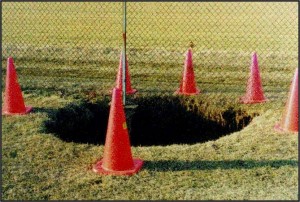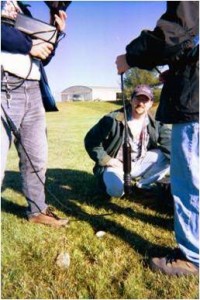 Geophysical Mapping of Shallow Karst
Geophysical Mapping of Shallow KarstResearchers at Temple University in collaboration with engineers at Lafayette College have used a 90-acre athletic area (Metzger Field) for several years as a research site to study the utility of multielectrode resistivity for mapping pinnacled bedrock and solution features associated with karst terrain. The results of multielectrode resistivity soundings at this site compare favorably with drilling data. We also used the site to study the relative merits of 2D and 3D resisitivity imaging for shallow karst targets.
In addition to drilling, we collected ground truth data collect about cavity dimensions using a SearchCam downhole video camera. Engineering students at Lafayette College built a triangulation system using the camera and a pair of laser points that we used to map the dimensions of a large void detected using resistivity tomography.
Other techniques investigated at this site include, misse-a-la-masse, seismic surface waves, and smoke tests.

Student from Temple University and Lafayette College with the SearchCam
Related publications:
Nyquist, J.E., H. E. Mintz, and M.J.S. Roth (2008) Mise-a-la-Masse and smoke tests for mapping vadose zone karst, The Leading Edge, 27:1510. DOI:10.1190/1.3011023. (Nov, 2008)
Xia J., J. E. Nyquist, Y. Xu, M. J.S. Roth and R. D. Miller (2007) Feasibility of detecting voids with Rayleigh-wave diffraction, Journal of Applied Geophysics, 244-253.
Nyquist, J. E., J. Peake, and M. J. S. Roth (2007) Comparison of an optimized resistivity array with dipole-dipole soundings in karst terrain, Geophysics, F139-F144.
Nyquist, J. E. and M. J. S. Roth (2005), Improved 3D pole-dipole resistivity surveys using radial measurement pairs, Geophy. Res. Lett., 32, no. 21, L21504.
Roth, M. J. S., Mackey, J. R., Mackey, C. ; Nyquist, J. E. (2002), A case study of the reliability of multielectrode earth resistivity testing for geotechnical investigations in karst terrains, Engineering and environmental impacts of karst, Engineering Geology, 65, 225-232.
